Selcouth Chronicles Week 20
Hello family and friends! Welcome to week 20 of the Selcouth Chronicles.
Week 20: May 19 - May 25
May 21 Ljubljana ->🚂 Graz 🚂 -> Vienna
May 25 Vienna ->🚂Prague
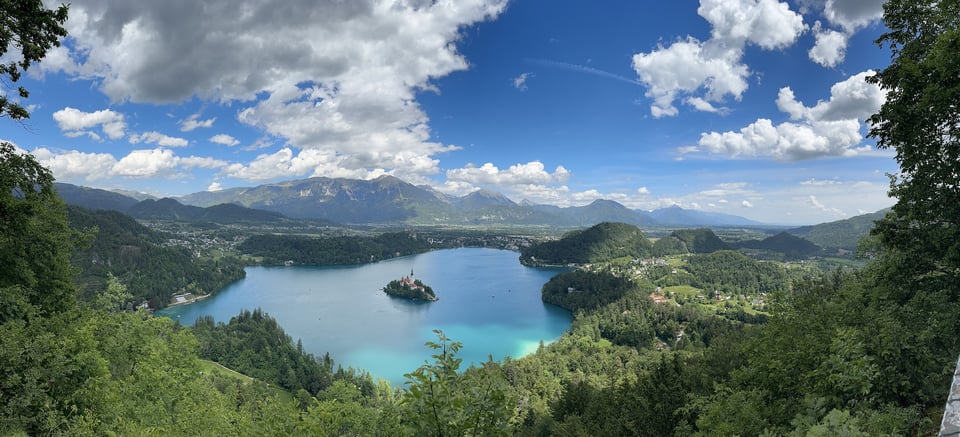
SLOVENIA, AUSTRIA AND CZECH REPUBLIC
Highlights: Bled Lake, exploring Ljubljana, Vienna’s history, Haus der Musik, Hofburg Palace, Demel Bakery, Spanish Riding School of Vienna, Osterreichischen Nationalbibliothek, Sisi Museum, Schönbrunn Palace, Schloss Belvedere, KHM
Caitlin:
Having been in towns and cities for a bit, we decided to start the week off with a day trip to Lake Bled on Sunday. The lake is a well-known destination for people in the area, and as we drove in we were surprised to see that there was an additional reason for visitors that weekend: a Spartan Race! Many of you know that Sean and several friends have entered a number of these races in the States, so it was funny to stumble upon it so far from home. Bled would definitely be a race location worth traveling for! After leaving the car we made our way to our first priority, which as usual was eating. Our café had beautiful views, and we enjoyed having our cake (a Bled specialty of pastry and cream) and some coffees on a terrace overlooking the water.
After cake, it was time for our main excursion – hiking! Bled is ringed by the enchanting Julian Alps, and while we didn’t have time for an especially long hike, we had been looking forward to a view of the town and lake from on high. We chose a short but steep trail up the side of the hills, and though we spend a lot of time walking these days it was nice for a change of pace that challenged us a bit more. Most of the walk was a dirt path, but near the top was a section of stairs so steep that James exclaimed, “Those aren’t stairs, that’s a ladder!” We nonetheless made it to the top of the trail, and were rewarded with a fantastic view.
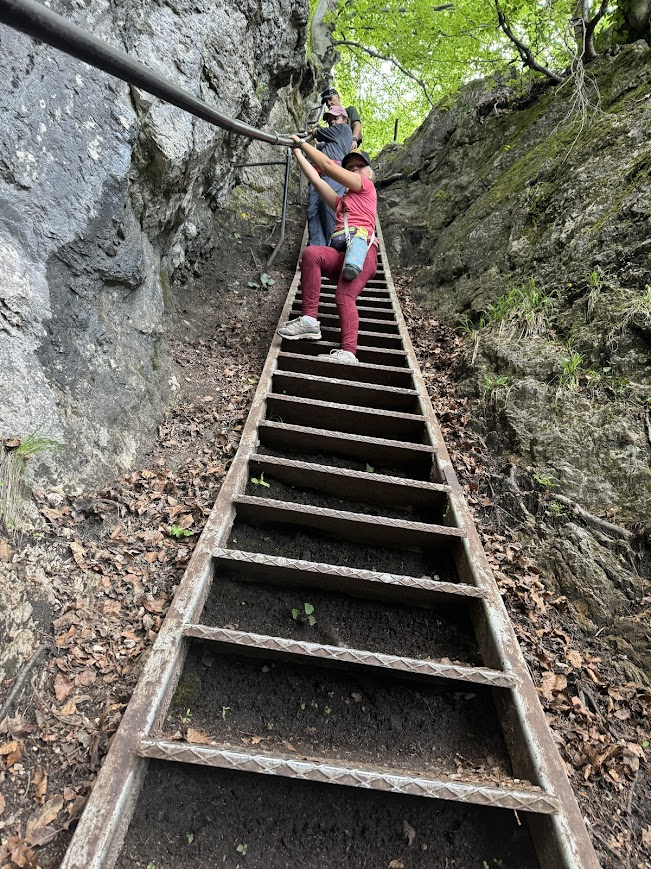
Bled surely had more to enjoy, but we headed back to Ljubljana after our hike because we only had two full days and wanted to explore the town. On Sundays most shops are closed, but locals and tourists were out at cafes and restaurants, enjoying the perks of good weather and a walkable town on a river. We made sure to find some of the notable features of the town, like the Dragon Bridge and the Triple Bridge. After stopping for dinner at a local restaurant, we made our way back to our lovely Airbnb for the night.
On Monday we explored the main attraction in town, Ljubljana Castle, perched high on a hill above the Old Town. The castle was interesting, and we enjoyed learning more about its history and the history of the town. The tower offered a terrific view of Ljubljana, and on clear days it is said that you can see almost a third of the entire country. After walking back down the hill we had a late lunch and enjoyed getting to explore the town a bit more when everything was actually open. I found Ljubljana to be charming and very livable. It was clear that the locals feel the same way, and it was fun to see how much they enjoyed their town, lingering at the local eateries, biking along the river, or lounging with family and friends along the riverbanks. In the evening, we were lucky to have a chance to sit and chat with our lovely host and her family. Slovenia’s recent history has been interesting and often tumultuous; our host Stasa was able to speak from a personal perspective and we really enjoyed hearing what she had to share.
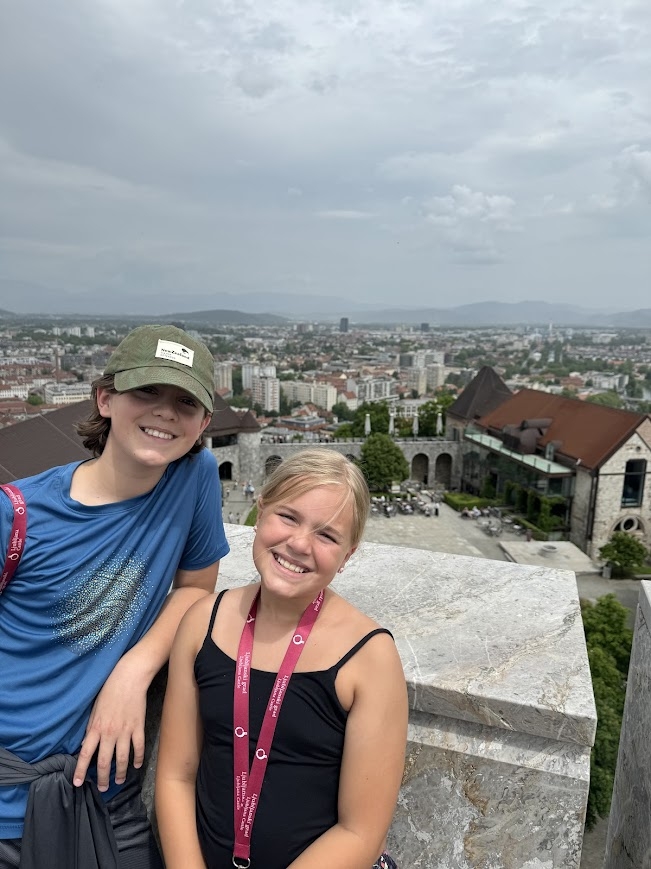
On Tuesday we hugged Stasa goodbye and took a train to Vienna. The trip ended up taking a good chunk of our day, but I was grateful for the down time to make a list of all the things that we might want to do in Vienna. By the time we checked into the hotel it was dinner time, but I discovered that one of the museums on our list was open late, so after eating we decided to head out to the Haus der Musik. Vienna holds a prestigious spot in classical music history, and the museum was a big hit for the whole family. To our delight, in addition to being informative it was surprisingly interactive, with many inventive exhibits. Plus, thanks to the late hours it was significantly less crowded than it would have been during the day. We could have spent more time exploring the offerings there, but by 9pm we were all feeling tired and headed back to the hotel to get ready for bed.
We thought it would be a good idea to start our first full day in Vienna with a walking tour, so once again we packed up our headphones and downloaded a Rick Steves guided walk. As usual, we made some spontaneous stops along the way, but we learned a lot about the city and were able to see the Opera House, Sacher Cafe (of Sachertorte fame), the Albertina Museum, Vienna’s Cathedral, St. Peter’s Church, some famous public bathrooms (yes, really), the Hofburg Palace with its many buildings, and more. We rewarded ourselves for our efforts by picking up treats at Demel Bakery, a local bakery and cafe legendary for having been the place where Empress Elizabeth (affectionately known as Sisi) ordered all of her chocolates. It was an endorsement we couldn’t resist!
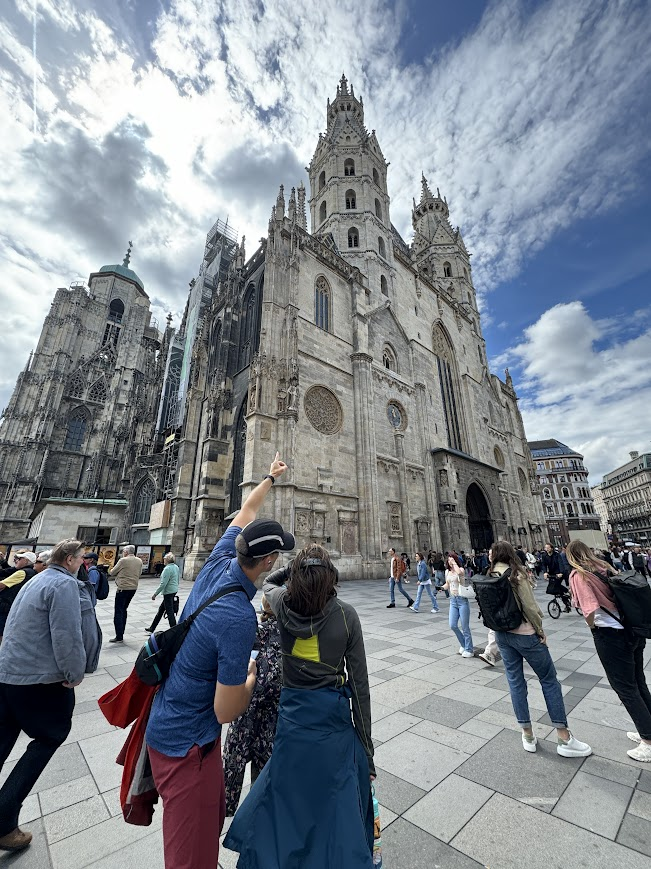
While we were out I was thrilled to get an email saying my request for a tour of the Spanish Riding School had been approved for later that day. As a lifelong lover of horses, I have known about the Spanish Riding School with its famed Lipizzaner stallions since I was in elementary school. It was very exciting for me to have the opportunity to see the school in person and hear more about their horses, riders, and training. We even got to go inside the stables! You aren’t allowed to touch the stallions, which was a real test of will because they are gorgeous and they are just inches away from you. No pictures are allowed in the stables, but a few of the horses were in large stalls out in the courtyard and we were able to snap photos when they leaned their heads out over the doors. I was happy to find that the kids and Sean loved the experience too, and it was hard to tear the kids away from watching the horses when it was over.
Afterwards, the kids and I ventured over to the Osterreichischen Nationalbibliothek, or Austrian National Library, located in a wing of the Hofburg Palace. There are a number of different wings of the library, but we visited the famed Prunksaal, or State Hall, which is renowned for its ornate architecture and artwork. This area isn’t a library in the traditional sense, where you can touch and check out books, but rather like a museum of historical books, sculptures, and artwork. It was a fascinating building!
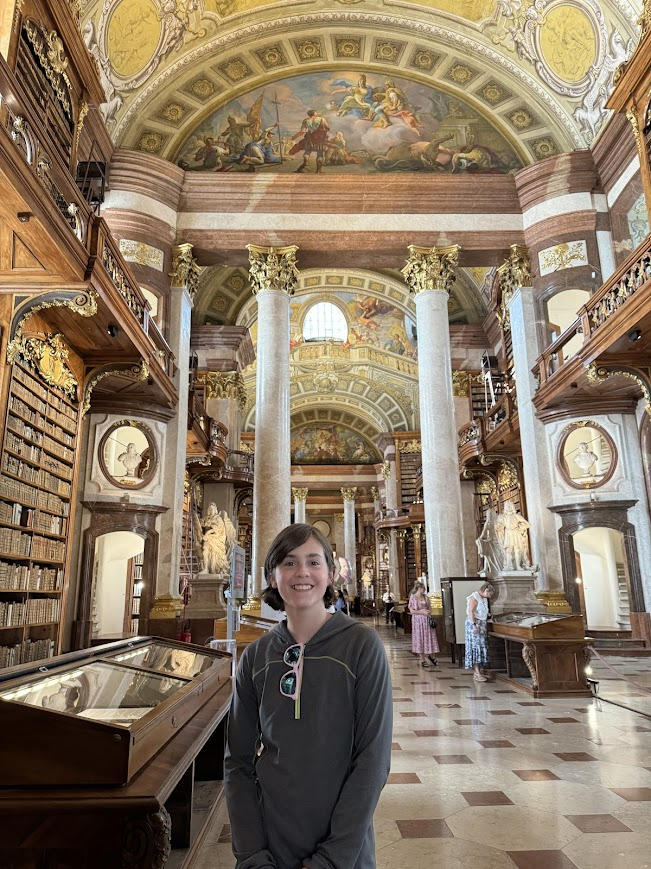
Thursday started with an early breakfast so that the kids and I could be ready for our timed entry to the Sisi Museum. Empress Sisi has developed something of a cult following, which seems to be the result of a clever marketing scheme, as she is more beloved in the present day than she was during her reign alongside Emperor Franz Joseph. She was a legendary beauty, but hated life in the Imperial Court and before she was assassinated in 1898 she was more and more absent from Vienna and her official duties. It was a sad but interesting story, and the museum had a wonderful collection of items from her life at the palace. From the Sisi Museum we entered our second museum of the day, which was a tour of the attached royal apartments of the Hapsburg family at Schönbrunn Palace. In addition to the spaces used for formal dinners and gatherings, we gained interesting insights into the life of Emperor Franz Joseph and the Habsburg family.
After Schönbrunn Palace we trekked to Schloss Belvedere, an 18th century former palace now broken up into several art museums. Sean was able to join us for Upper Belvedere, which has many interesting works by artists including Monet and Van Gogh, but is especially known for its Klimt collection. I wasn’t very familiar with Gustav Klimt when we visited; I’d only seen a few of his most famous female portraits and knew he was from Austria. I was delighted to find that I enjoyed his work much more than I anticipated and was impressed by his range of styles.
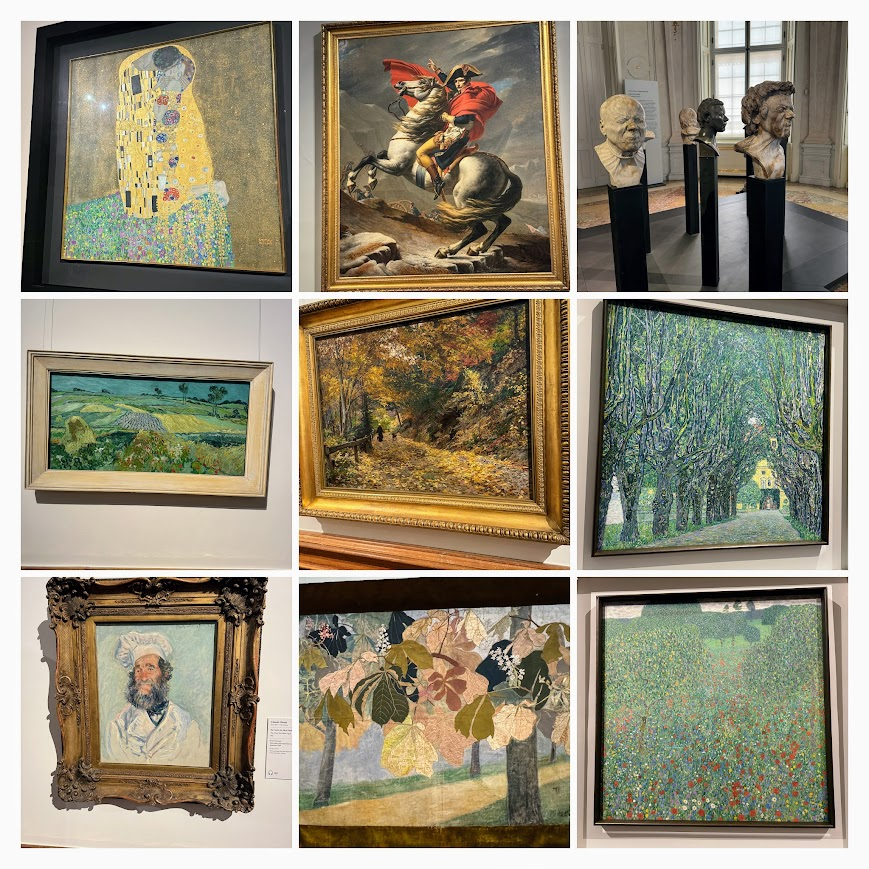
Next, the kids and I had a snack in the palace gardens before deciding that we’d like to see modern art for a change of pace. We walked to Belvedere 21, which is the modern art museum. The three exhibits we saw were… well, a little too edgy for our taste. Plaster casts of roadkill and abstract paintings of someone vomiting just didn’t speak to us. We left disappointed. However, as we began our walk back to the hotel I told the kids that we would be walking past the final museum of the Schloss Belvedere trio, Lower Belvedere. We had steered clear because their medieval art collection was frequently mentioned and we aren’t big fans of that genre. However, we were feeling proud of ourselves for already making it through four museums in a day, and we decided that maybe we’d poke our heads in briefly, just to up our museum number to five, which sounded impressive. That was the plan, but we actually stayed for almost an hour, enjoying collections of Ukrainian Art and female Austrian artists that were exhibited, along with admiring the old palace. We still opted to skip the medieval collection, but we left with a full five museums for the day and were pleased that our last-minute addition allowed us to end the day with a museum that we enjoyed!
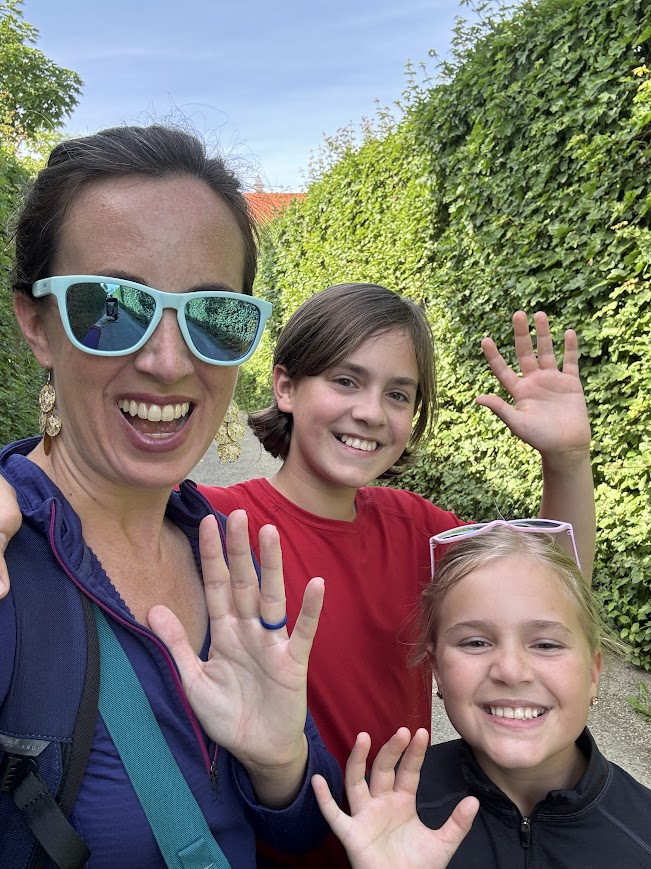
On Friday we started the day by seeing a performance at the Spanish Riding School. Seats can sell out months in advance, but we were able to get standing room tickets. It was an amazing show! I had described their type of exacting dressage to Sean and the kids as ballet for horses, and we weren’t disappointed: the show was great! Afterwards, we walked to Kaiserliche Schatzkammer, the Imperial Treasury, which was filled with fantastic treasures from over a thousand years of Imperial rule. Next we had lunch at a lovely cafe and made our way to the Kunsthistorisches Museum Wein (KHM), which is Vienna’s great art history museum. Their portrait gallery is especially well-known, and has work from artists like Rembrandt, Vermeer, Raphael, Dürer, and more. By the time we emerged into a light rain, the day was gone and we headed back to the hotel to pack. Even though we felt like our days in Vienna were full, there were still tons of things on our list that we hadn’t had time for! It’s an amazing city.
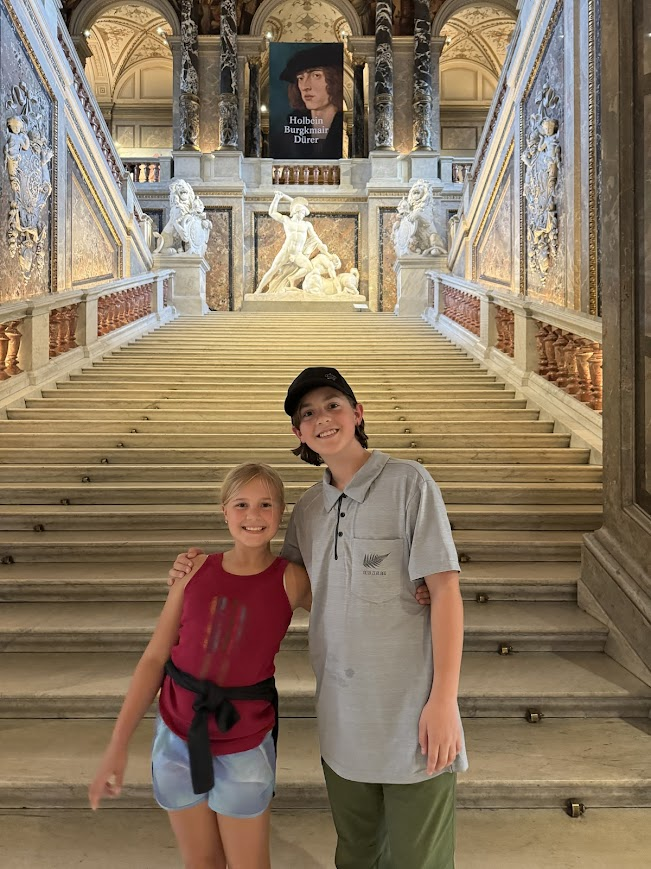
Saturday was another travel day, as we set off for Prague. Fortunately, this time we were able to take a single train, but with the distance and the scheduled stops it was still a four hour journey. After checking into our apartment it started to rain, which we used as an excuse to take care of some trip planning and calls to family. The rain stopped by dinner time, and though we were all tired we decided to walk through town a bit and try a restaurant. We were well-rewarded for our efforts, because dinner was one of the best we’ve had in a while, and it felt good to stretch our legs. It was only a brief introduction to Prague, but we’re looking forward to seeing more in the next few days before moving on to Germany!
Abby:
On this trip we’ve mostly been in cities, so it’s always nice to have some time in nature. Starting off the week, we took a day trip from Ljubljana to Lake Bled - probably Slovenia’s most prized natural landmark. It’s a huge lake with mountains surrounding it and Slovenia’ only naturally-occurring island in the middle. It’s very pretty!
The drive wasn’t too long even with weekend traffic; it took us about an hour. When we got there, we had to find a parking spot. Our Airbnb host told us that we could park our car at a hotel if we had a snack at their cafe. This particular hotel used to belong to Tito, the leader of Yugoslavia when it was a country, and we weren’t opposed to the idea of having a snack in a place with such rich history! Also, at the cafe they serve kremna rezina, Bled’s traditional cake, which we wanted to try. The cake is layers of fried pastry under a thick chunk of cream custard under lots of whipped cream under more fried pastry, all under powdered sugar. The name literally translates to “cream cake.”
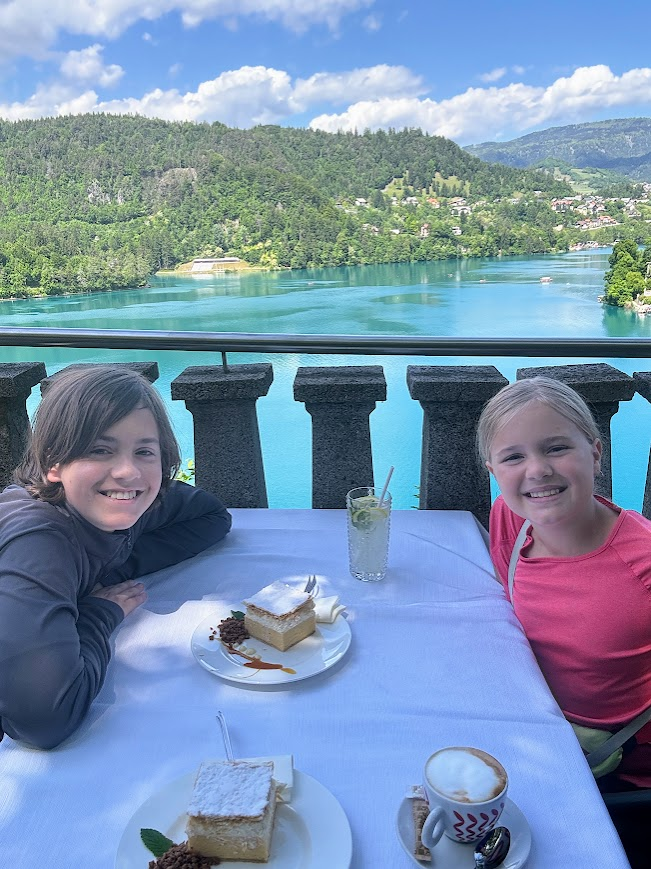
After having a delicious filling of cream cake on a pavilion with a beautiful view of Lake Bled, we headed off to take our hike. It was a bit steep, but it provided wonderful views of the lake. Some parts were quite the adventure, though! One part was so narrow that they installed a rope on the cliff next to you so that you wouldn’t accidentally trip and fall off the edge. There were also some stairs that were steep enough to be called a ladder by James. It was funny to watch other people trying to maneuver themselves down them. We made our way up, awkwardly clinging to the bar. It would have been better if we could have grabbed onto the stairs for support, but many people’s feet have touched it so we didn’t want to put our hands on the platforms. After we got past the hardest part, it was a fun hike. When we finally got to the top, there was a breathtaking view of the scene of Lake Bled: the towering mountains that looked magical in the gray-blue light, the shiny lake with a tiny little island bobbing in the middle and atop it, a church that looks like a mini castle. We took some selfies in front of the panoramic view before heading back down to get the car.
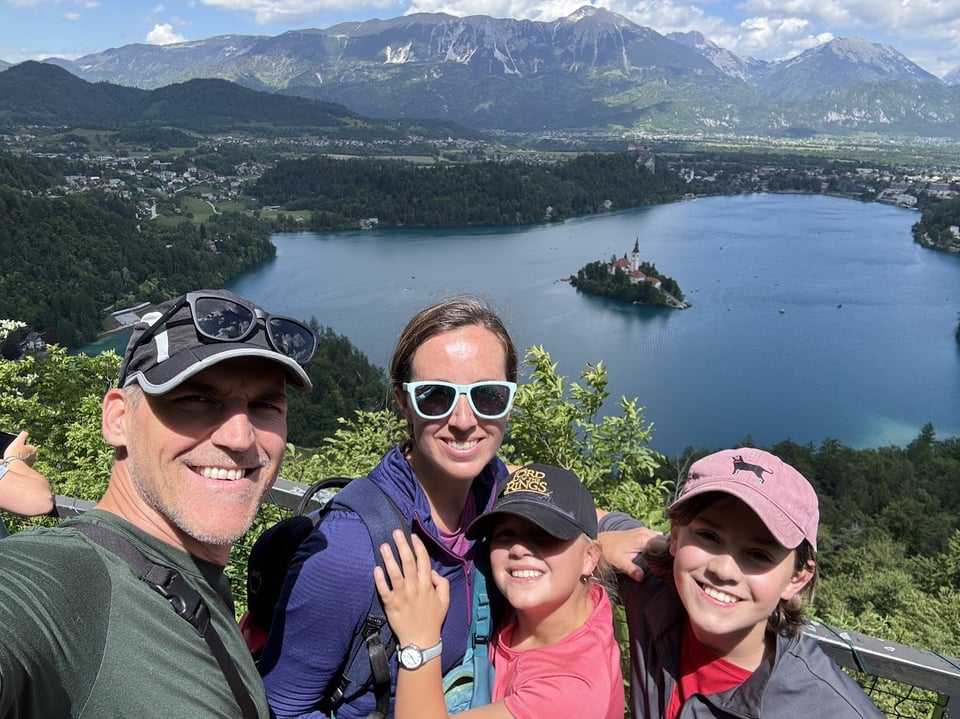
As we get more into Europe, we’ll be heading more into nature and I think nature is the best part of traveling. Next week we’ll be heading to Rhine Valley, one of the world’s most beautiful landmarks!
Sean:
Vienna is one of the places in the world that worms its way into your subconscious over time and becomes romanticized. It’s hard to believe how much of a role the city played in the histories of the great artists Beethoven, Mozart, and Strauss. Similar to Florence, walking the streets where these great masters strolled, pondering their next great piece, is quite amazing. The Viennese are quite proud of their culture and history (and food), and the city oozes a charm as you walk through it that’s hard to describe. One truly fun, long-standing tradition in the city is the Spanischen Hofreitschule (or Spanish Riding School for us English speakers) with their Lipizzaner stallions.
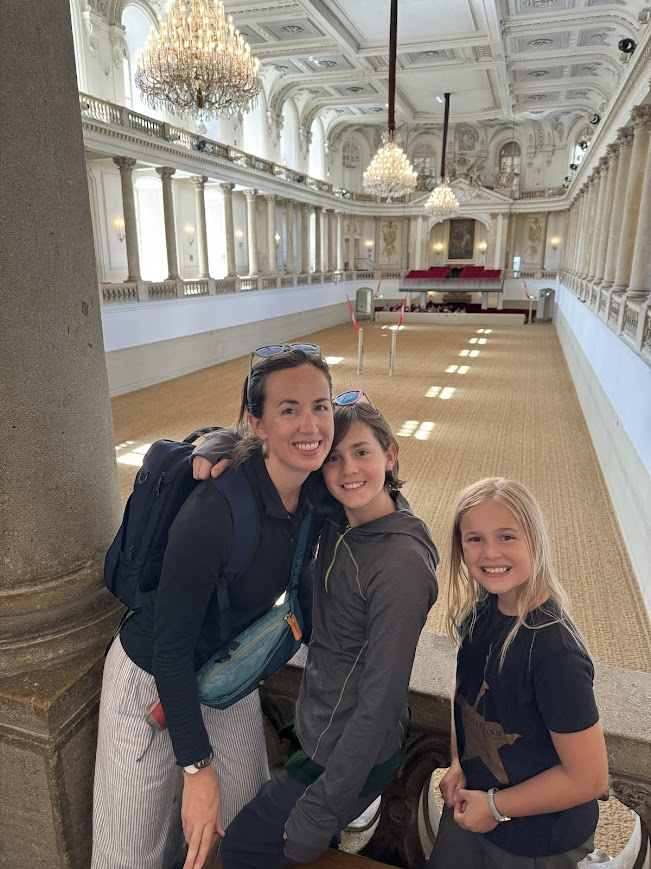
The story of these horses is actually somewhat amusing, and we were lucky to learn about it during a tour of their facilities on Wednesday afternoon. Back in the 16th century, the new emperor of the realm had been chosen but he had been raised in Spain. When he was moved to Vienna, he did not speak the language but had been breeding horses in his previous location and wanted his herd brought with him. Moving a herd of 200 horses was not easy, and many of the horses were stolen or perished during the long trek to Vienna, so the emperor had to start breeding again. The horses quickly became associated with the emperor, whom everyone in Vienna thought was strange, with his foreign customs and language. Due to this, they referred to everything they thought was strange and foreign as being “Spanish,” and our tour guide informed us there’s still a saying in Vienna that is used when someone thinks something is strange: “That is Spanish to me.” And thus, the Lipizzaner horses were called Spanish horses, and their training grounds, the Spanish Riding School.
As Caitlin mentioned, the tour was quite enjoyable. They took us into the stables, where we could see many of the horses, and even saw a dark brown horse. The guide, Johanna, informed us that this is not as strange as it first appears. About one in a hundred foals have this dark coat and it is the result of a recessive gene pairing. All other Lipizzaner horses are born with a gray coat that changes to the familiar white as they age. In fact, the school believes that the dark horse is a good omen, and when the stable has at least one, it means that the school will live on. The tour also took us into the arena where the horses do their performances. It was built by Emperor Charles VI in the 18th century, and there is a large portrait of him at one end. To this day, the riders salute the portrait as a way of thanking the emperor for the beautiful arena they can perform in. We were able to take pictures of the horses outside in a courtyard where some of the horses were stabled. It was hard to tear the kids away from the curious horses!
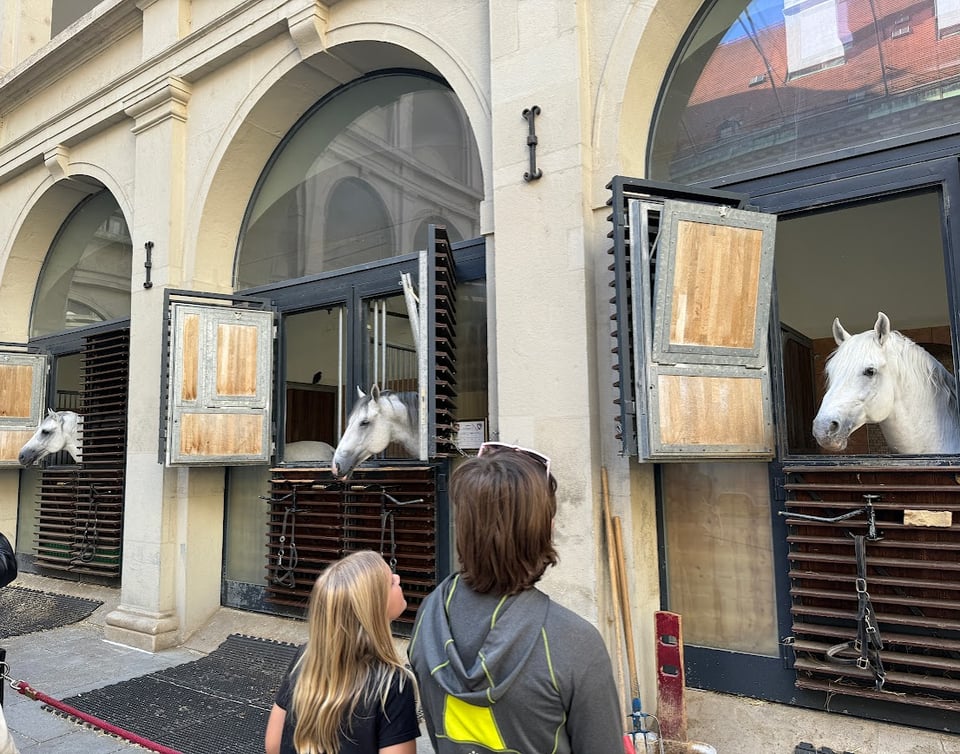
We were able to get standing-room-only tickets for a full show on Friday morning, and we were all excited. After going to the wrong floor (need to learn some more German!), we eventually found where to stand and luckily got a spot with a decent view. The moves the horses do are split into “on the ground” and “above the ground” schools. All of the horses that make it through the school can do the on the ground work, but not every horse can do above the ground. This is distinguished by the color of their blanket. The show was done in three parts, the first being one horse being led by the long rein. This is where the rider actually walks behind the horse holding long reins. I was awed by this, as the trust the rider must have in the horse to be standing right behind it was immense, and the two walked through a well choreographed performance together. Next was a set with five horses, four with riders walking alongside and one with the rider astride the horse. This had more action as the horses did some in the air work as well as various on the ground tricks. The show ended with four horses with riders on, with the four doing a lot of jumps and other tricks in the air. In all it was a truly amazing experience, as the horses were precise and the relationship between the horse and rider was apparent, with each trusting each other immensely. If you ever find yourself in Vienna, I would highly recommend you pay a visit to the Spanischen Hofreitschule and see a show.
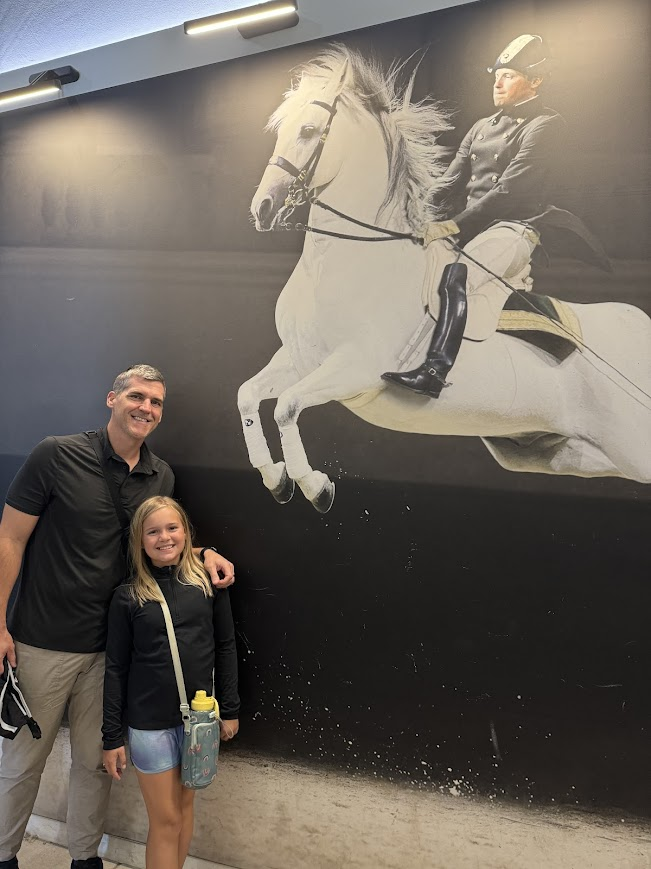
James:
The Haus der Musik in Vienna is a wonderful place. It catalogs the life of the most famous composers in history and has a ton of fun activities to do in between the learning. We started with the musical stairs: on the right side of every step is a black or white tile, and if you step on it, it plays a sound. It was a lot of fun, and we spent a few minutes experimenting with the noises. Off to a good start! After playing musical stairs, you get to make more music. A giant screen and four sensors allows you to play dice waltz. Dice Waltz is a game where you roll virtual dice to determine what notes go where. After everyone rolls four times on their respective dice, you can listen to your very own group composition. It’s a lot of fun!
The next rooms explain the science of sound. Special tubes filled with neon-colored dust show you what sound waves look like by sending pulses through it. The dust vibrates, making the waves visible in the shapes they make. It’s just a lot of squiggly lines, but it still manages to be awesome. Next up was sound from different perspectives. Sets of headphones on racks allow you to listen to music through an animal's ears, which is really weird. For example, turtles apparently hear everything in a deep bass. They don’t hear higher pitched sounds!
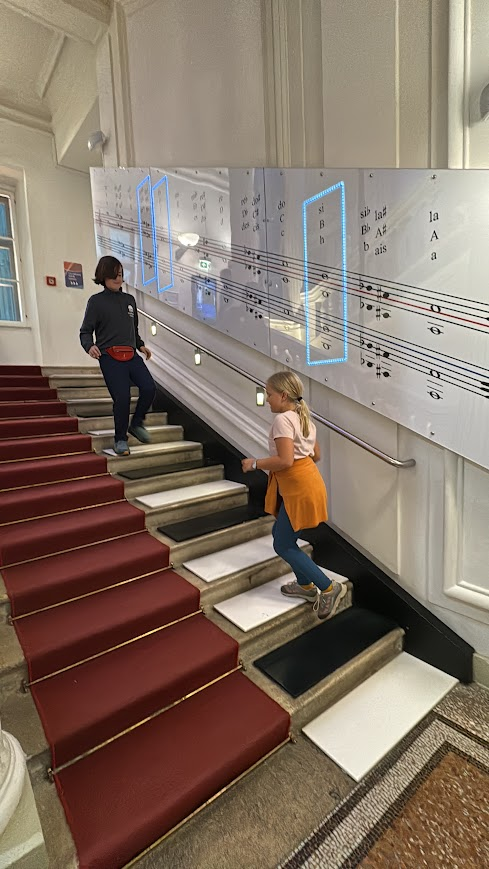
The museum then shows you different types of instruments. Aerophones, which include trumpets and trombones, work by vibrating air. Idiophones create sound by making the instruments themselves vibrate - like the gong and the triangle. Membranophones make sound by hitting a stretched membrane; this category includes things like drums. There are also chordophones, which work via vibrating strings, like guitars and violins. They also have some instruments on display. My favorites were the trumpet (of course) and a truly ridiculous drum that took up half the room.
The next rooms are dedicated to the lives of famous composers like Mozart, Beethoven, Strauss, Haydn, Mahler, and Schubert. The exhibits are full of things like letters to their families, old instruments, and experimental compositions. I think that compared to the other rooms, these are less exciting because they have fewer interactive parts. It does have plenty of interesting information, though. For example, I learned that Mozart was apparently the life of any party and loved to dance. He once wrote to his father saying that he had hosted a party that started at 6pm and ended at 7am the next day!
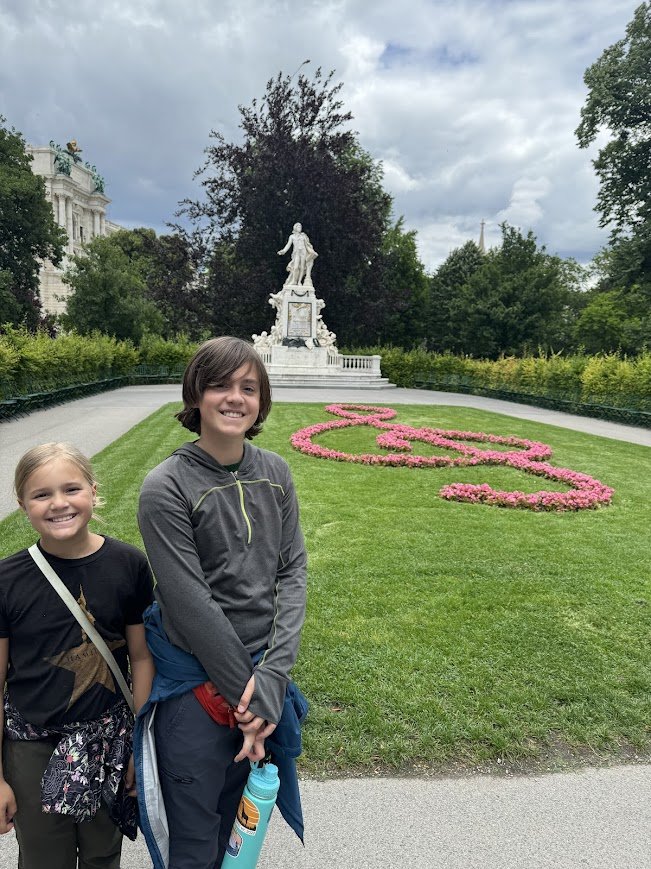
Finishing off the museum are two of the coolest rooms in the place: the virtual composer and the CLONG creator. The VC room allows you to conduct the famous Vienna Philharmonic via a giant screen and motion sensors. It’s fun, but it is a little hard to keep the tempo steady. The SONOTOPIA room is the most interactive one yet. You look into a VR headset and see a white blob. You get to customize it- the color, its looks, and its spikes. It’s supposed to represent a sound, and when you’re done with it, it goes onto a screen on the roof of the adjoining room. You can lie down on special cushions and watch your creation float across the screen. It’s beautiful.
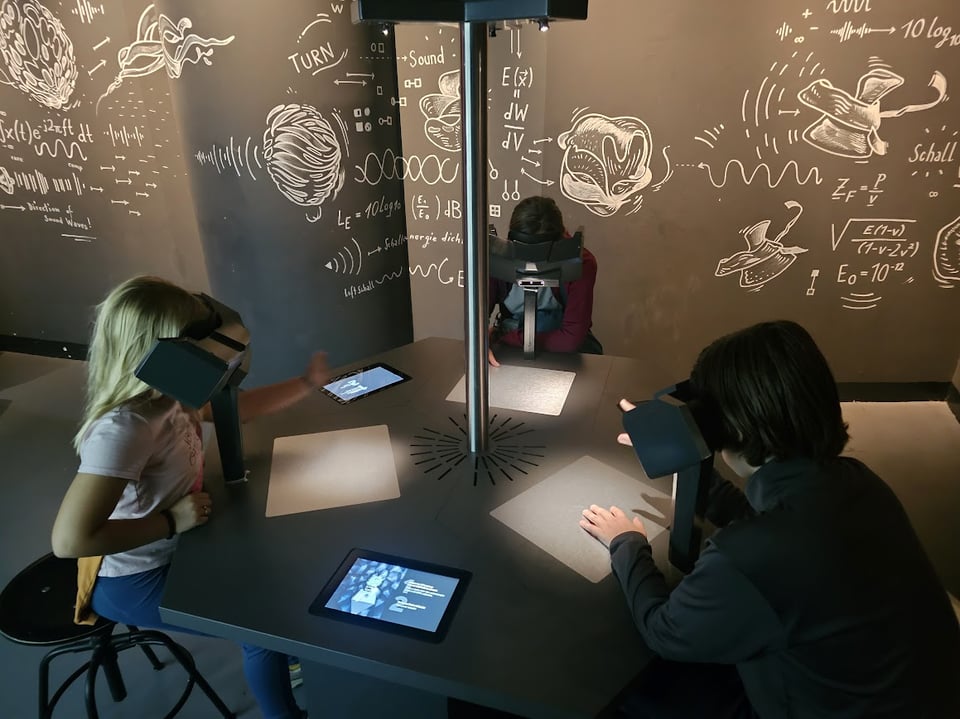
Music is something I love, and learning about the science behind sound was fascinating. I think that the Haus der Musik is a wonderful museum!
See you next week!
Sean, Caitlin, James, and Abby
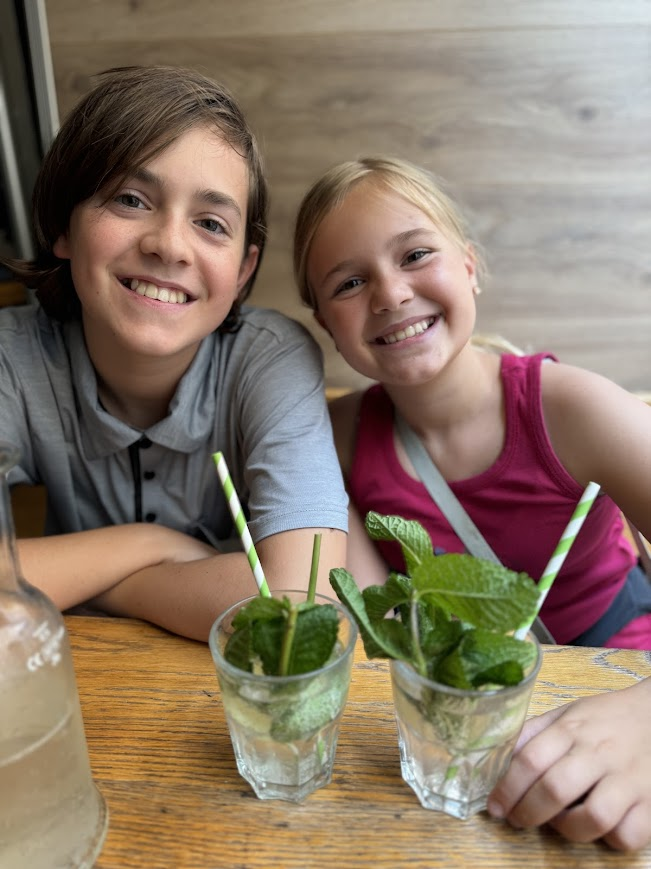
Catching up? Read week 1, 2, 3, 4, 5, 6, 7, 8, 9, 10, 11, 12, 13, 14, 15, 16, 17, 18, or 19.